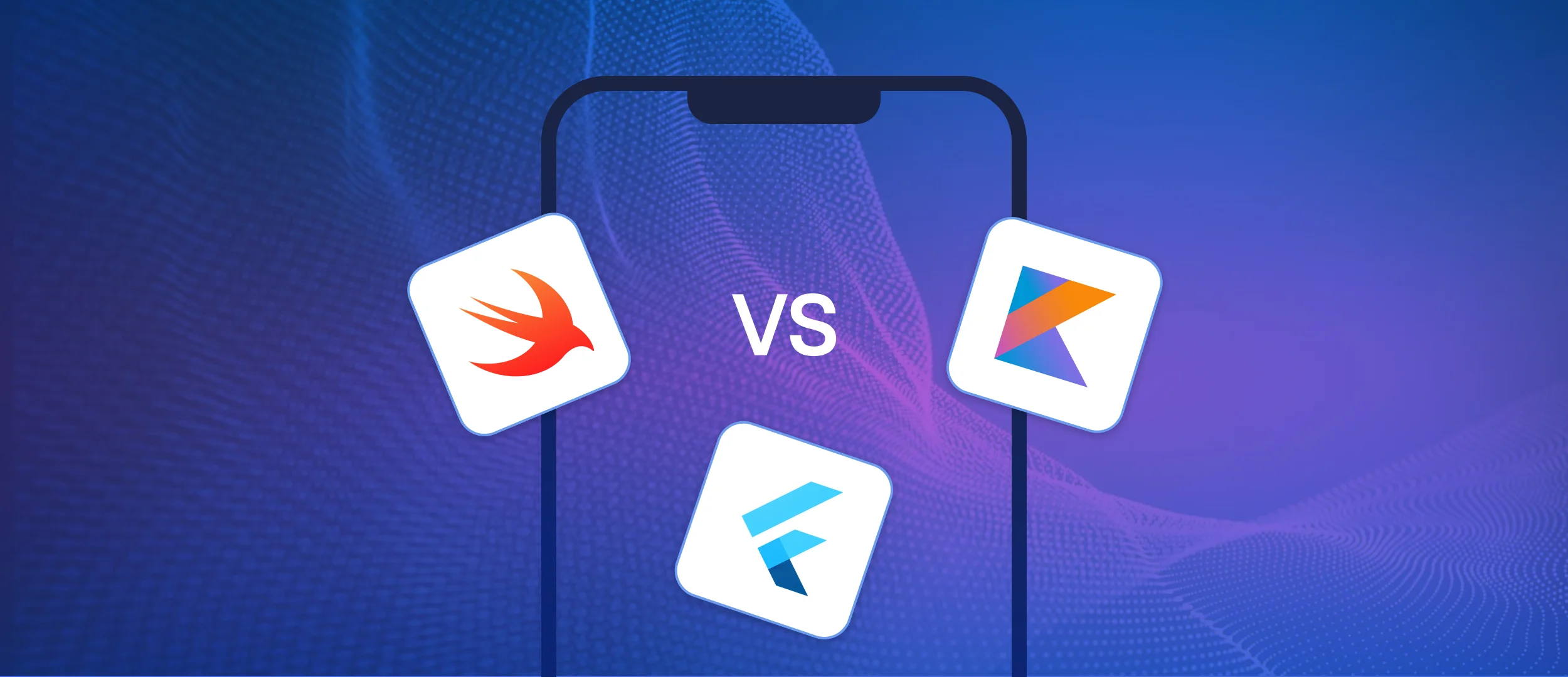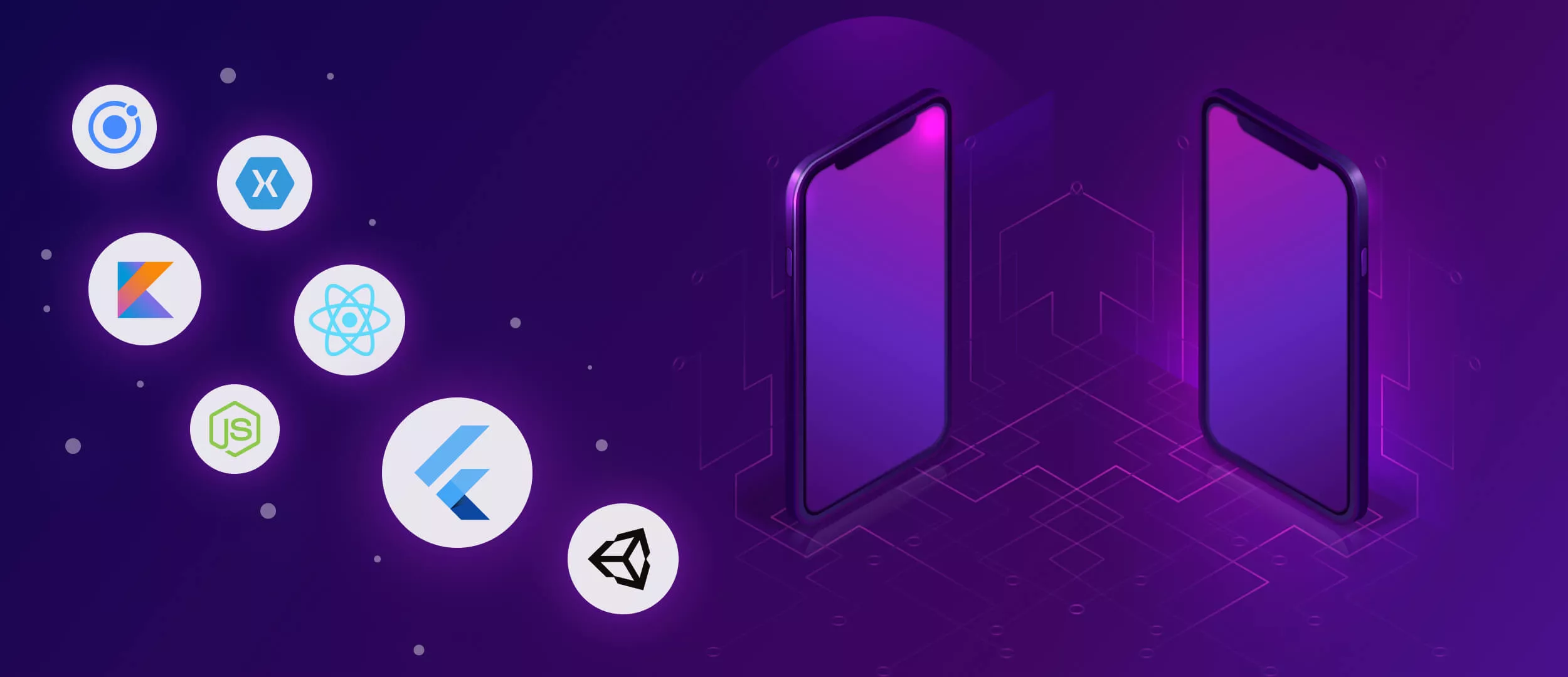
The Flutter framework for cross-platform development has quickly progressed. It gained the market after Google introduced it in 2017. In 2021, it went the extra mile and expanded its support to web and desktop applications. With the framework's growing popularity, the number of Flutter app development companies has also grown. Our article today is on how to choose Flutter software developers in the modern world. How to find those experts who will meet your business needs through ideal technical implementation.
Today, Flutter is a popular cost-effective means of app development. It allows crafting scalable solutions with a single codebase for iOS and Android. What’s more, the development process on Flutter is quick and efficient. It accelerates time-to-market, making the framework the top choice of about 46% of software developers. The key aspects contributing to that are the hot reload feature, extensive widget library to create unique UIs and apps’ high performance with smooth animations.
Now you know which way the wind is blowing in modern development. Let’s speak about how to choose the best Flutter app development company.
Top Flutter App Development Companies
If you are a businessman ready to improve your software solution or a founder of a startup looking for cost-effective software to speed up time to market, you are likely wondering where to find a professional Flutter app development company. The right chosen software vendor is the key to your app's success. The developers should not only be Flutter experts with proven cases but also have relevant expertise in your niche. So, let’s turn our eyes to the list of top Flutter app development companies. We've formed after a careful analysis of the open resources.
Stfalcon
Stfalcon is leading the list. Our developers combine technical knowledge and a strong commitment to the products they develop. Located in the heart of Europe, Ukraine, Stfalcon serves clients all over the world. The exceptional quality of development demonstrated for almost 16 years has been regularly noted by professional resources. Clutch included us in the Top 1000 Global Service Providers. Stfalcon was named a Top App Developer in Ukraine and that's not all.
Our team guides our clients and helps them develop Flutter solutions. We help them optimize their strategies and scale their business. Industries we transform include logistics, travel, education, healthcare, e-commerce, fintech, and real estate. That makes us a trustworthy Flutter vendor for varied projects in all these spheres.
Using the latest tech innovations and modern tools is the strength of our experts. It allows them to deliver cutting-edge efficient solutions.
We deal with Flutter native and cross-platform app development as well as app upgrade services. Our team can craft a custom app on Flutter or offer your migration services of the existing solution. We also provide maintenance and support services for Flutter products. It’s essential to mention that our team introspects every product of our clients becoming a part of it. So, by choosing Stfalcon you not only solve the technical part but get expert advice on how to optimize your product. Sometimes we even help improve business aspects.
Our clients always note our professionalism, impressive dedication, and resilience. Even under the challenging conditions of the Russian invasion, our team delivered the final products exceeding our client’s expectations. They expressed their high satisfaction with the projects’ outcomes. Our customers noted our strong long-term collaboration potential. They often continued to work with Stfalcon on additional projects.
Want a web app that does more?
Let's build a solution that's smart, sleek, and powerful.
Alina
Client Manager

Cleveroad
Cleveroad is a company born in Ukraine. It has now headquarters in Estonia and offices in the USA and Norway. It is recognized as a leading Flutter app development company in Estonia. Cleveroad applies Flutter's expertise to healthcare, logistics, education, eCommerce, and Fintech spheres.
Prioritizing innovation and transparency they specialize in native mobile and web development, microservices, and cloud solutions. The company deals with data science, machine learning, industrial IoT, AI, and AR for business solutions. They deliver high-quality products for private entrepreneurs, businesses, and startups. Based on general reputation and client feedback the vendor rates high among Clutch B2B service providers.
SolveIt
The company’s location is in Poland and it is known as a full-service software developer. They do project discovery, develop and design software solutions, launch, and support them. SolveIt provides mobile solutions for startups and small and middle-sized businesses. They have an in-house team of over 50 professionals.
For over 8 years their specialists deliver software with engaging and intuitive design. They extensively use Flutter for cross-platform development. Their portfolio includes high-quality solutions for Healthcare, FinTech, Ecommerce, and Travel industries.
The company is reputed for outstanding project management, reasonable costs, and on-time delivery.
Uptech
This software development company has offices in 5 countries. They are Ukraine, Poland, Cyprus, Estonia, and the USA. They provide a full range of services. That includes product discovery and management, UI/UX design, and custom mobile and web development. Uptech’s Flutter expertise, lean product-development approach, proactive team, and commitment to understanding their clients’ needs favor their position in the market. They have operated in it for over 7 years.
The company can build an MVP and help you reach the market in just 3 months. They help startups with software development and team extension. Uptech also services companies on the Fortune 500 list. They claim their mission is to change people's lives through the software they build.
Some resources acknowledge Uptech as a top player in the field of Flutter development for such industries as e-commerce, healthcare, proptech, and fintech.
Droids on Roids
Droids on Roids is Poland-based but services clients from over 20 countries. This Flutter development company primarily focuses on mobile apps for businesses and startups. Adapting to the speed and needs of their clients, they make their development process comfortable and transparent. They match the expectations and budgets of their customers.
Droids on Roids has an extensive portfolio of projects in various industries. Foodtech, mCommerce, Medtech, Fintech, and IoT are among them.
The company has a staff of 85 people on board. Almost a quarter of them constitute their Flutter development team. More than 7 years of Flutter experience allows Droids on Roids developers to build innovative high-performance digital products from concept to launch. If you need web development, a cross-platform solution, or Flutter integration testing, look closer at them.
Surf
Being an American-based company, Surf positions itself as a pioneer of Flutter development. They have carried out over 25 Flutter projects since 2019 in FinTech, MedTech, FoodTech, and eCommerce. You can find Société Générale, Wellacy Health, MARS, SAP, and KFC among their clients. Surf can be your Flutter vendor if you need software development for the audience using various devices. Look at them if you lack in-house resources, or need personalized UI for different user groups without UX interference. They build effective partnerships beyond conventional project activities.
The company is Google-certified. Surf is recognized among the top Flutter development companies in the global market.
MindInventory
MindInventory is a midsize Indian company. It has operated in the Flutter solutions market for about 6 years. They offer end-to-end services of Flutter app development. With over 40 Flutter developers onboard the company provides variable services. They include product reengineering, ML, AI software development, and data science solutions creation. They combine Flutter with other modern technologies to craft cutting-edge products.
MindInventory team can develop a custom cross-platform application from scratch. They can also upgrade an existing Flutter solution based on code audit. Look at them if you want to optimize your product to bring it into line with the up-to-date technology trends. MindInventory can also help you get a custom touch-up for your software. It does not matter if you want a custom widget, a unique app button design, a chat window pop-up, etc.
The industries they serve include Gaming, Retail, Education, Automotive, Healthcare, and Financial.
Vention
The biggest Flutter development company in our rating has the widest talent pool. They boast over 3000 engineers all over the world and 20+ years of market presence. Their developers work in different time zones. It allows them to service clients in different parts of the world. They seamlessly provide them with end-to-end software development expertise.
With headquarters in the USA, Vention works with venture-backed startups and growing businesses. The company offers a wide range of services: IoT and blockchain development, AR/VR, AI, Cloud & DevOps.
Having 500+ industry-leading clients such as IBM, PayPal, PwC, Mount Sinai, and Postman on their list, they eagerly take on challenging projects of any size and complexity. Since they are the leading Flutter app development company in the USA, their rates and project budgets are high. They are more expensive than other companies on our list. That’s why Vention is more suitable for big, ambitious companies. Consider them if you are focused on new opportunities and business expansion.
Now as we see the top Flutter app development companies, their strengths, and specifics, let’s proceed to our main point. It’s how to make the right choice of the Flutter development team.
How to Choose the Best Flutter Development Company?
To choose the best vendor for your digital product you should be well-aware of how it should work. Think also about the features and design elements. Understand what’s important for you in product development. It may be the best design, the fastest time to market, data security, scalability in the future, etc.
Don't forget about the criteria that can become deal-breakers for you in partnership. When you know everything mentioned above start your market studies.
Tech proficiency and experience
There are many development companies. You should ensure they have Flutter experts with in-depth framework knowledge and relevant experience. Modern professionals should be aware of the latest development trends and best practices. The expert must have expertise in the related technologies. They are Dart programming language, API services, Firebase database, real-time data synchronization, etc.
Make sure the company you consider as your vendor-to-be has proven prior Flutter app development experience in your niche. Check their portfolio to find high-quality software solutions on Flutter. It’s nice if the projects are variable, with proper design aesthetics, and of different complexity.
Successful Flutter Cases
When looking for a trustworthy Flutter vendor, make sure they have a proven portfolio of successful cases. Keep in mind that the development company must have expertise in your industry. It will guarantee they realize all the development challenges and specifics to provide you with a secure, efficient, and compliant solution.
If your project lies in Fintech, they need to be aware of all the security requirements. Legal regulations, global and local, as well as payment gateway specifics, are also important.
Without the knowledge of all the details in your domain, developers are unlikely to create high-quality software tailored to your needs on time.
So, before making the final choice evaluate Flutter development capabilities, company’s proficiency, previous project’s quality, efficiency, and design aesthetics.
Communication and collaboration
A critical aspect of any cooperation is communication. Without an established flow the project will fail. Try to understand how the development team handles communication. It's important from the initial inquiry, throughout the whole project to its completion. Find out the tools they use to communicate within the team and with you as a client. Learn the frequency of project updates you will get.
Note their eagerness to answer your questions and explain technical concepts clearly. Are they ready to keep you up-to-date? Is the overall process transparent? You may also ask about their protocols for issue resolution. Additionally, check if they are ready to hear your feedback and make the necessary adjustments.
Client reviews and testimonials
When studying the relevant experience, check reviews and feedback from the company’s clients. It has been and remains the most effective way to get insights about the development team, their style of work, communication and collaboration, problem-solving capabilities, as well as project outcomes. You can check the relevant open platforms, like Clutch, LinkedIn, GoodFirms, or Google Reviews. Another option is to request directly from the agency you are considering.
Some vendors can facilitate direct communication with their previous customers. So, you can even get unfiltered insights about their work. Positive impressions from the clients in your industry can become an indicator that the developers can deliver a proper Flutter app for your business. It can give you the go-ahead for cooperation.
Let’s now review the reasons to consider Stfalcon a top Flutter app development company and choose us as your reliable vendor.
Why Hire Stfalcon as a Flutter App Development Company
Stfalcon has been a custom Flutter app development company for over 5 years. We have a proven portfolio of Flutter projects and positive client feedback. They noted our ability to admirably perform, even during high-pressure situations. Find us on Clutch and make sure in person.
With us, you can hire a dedicated Flutter team for your project. It means that our engineers are armed with all the necessary tools and Flutter-related technologies. They will fulfill a full-cycle development of your project from scratch.
With our team and Flutter framework, you can reduce your software development time by up to 60%. The technology allows simultaneous development for different platforms. It is also cost-effective. You can quickly launch your product and start gaining profit ahead of competitors.
Stfalcon is experienced in many fields. We know the bottlenecks and regulations of many industries. So, we guarantee our clients high-quality, visually attractive custom Flutter solutions. Flutter is a goldmine for businesses of all sizes. To give you some examples we will share a few cases from our portfolio. Find more cases on our website.
Stfalcon developed a mobile app for iOS and Android. The request came from the online community of authors and book lovers. The key purpose was to help readers discover new literary works, authors, and genres with reviews for a bargain. As a result, the client got an up-to-date, high-speed product. The users can now enjoy an easy-to-use library of books wrapped in a user-friendly app.
To contrast the relatively small project, we will also mention a project under NDA. It was carried out by Stfalcon for one of the largest food delivery companies in the world. It operates in more than 40 countries. The task was to build a B2B tool for effective communication between restaurants and food suppliers.
When the number of orders exceeded 500 million a year, they failed to find a suitable tool for collaboration. The answer was to create one. Our client got a software solution of the highest quality. Stfalcon’s team at the same time has expanded their expertise.
Conclusion
If you are interested in Flutter development, contact our expert to discuss all the details. Stfalcon has proven expertise in Flutter development. We have almost 15 years of software creation expertise for various industries behind our backs. Our experts can give you detailed answers to all your questions. Based on the results of communication, we will provide you with a careful estimation of your project costs. We will eagerly develop a ground-breaking Flutter solution for you to outperform your competitors and win the market.
FAQs about Best Flutter App Development Companies
What is Flutter?
It’s one of the most popular frameworks for web and mobile development today. It's an open-source UI toolkit built by Google. The toolkit allows building cross-platform yet native-looking solutions with a single codebase.
How much does it cost to develop a Flutter app?
The budget of any project depends on many aspects. They are the app’s functionality, complexity, and requirements. What’s more the form of cooperation, developers’ rates, and level of expertise also matter. One is for sure Flutter can save up to 60% of your costs, compared to native development, and up to 70% on maintenance. Besides, adding new features at the later development stages will take you about 20% less time. It will also save your budget further.
How long does it take to develop a Flutter app?
With Flutter you can develop a single code software for different platforms simultaneously. The average time of Flutter development is less than with other technologies. So, a simple app can be developed in a 2-month term, while a complex solution may require half a year and above.

 Read the full case study
Read the full case study
 Read the full case study
Read the full case study


